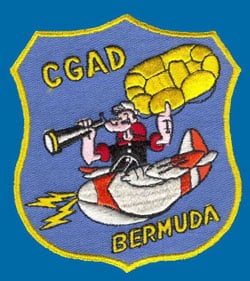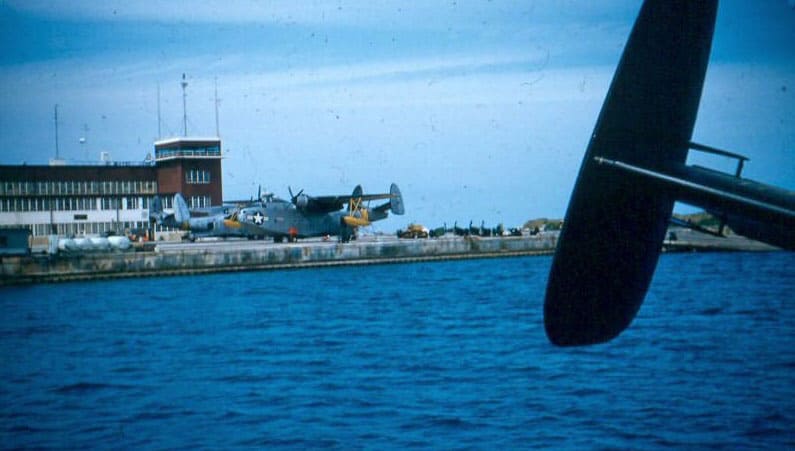 The assets of the former Naval Air station at Bermuda, established during World War II, had been turned over to the control of Naval Station Bermuda after the war. Patrol squadrons returned again when, as a result of the Korean War, it was deemed necessary to have advanced ASW patrols to counter the increased Soviet submarine activity. VP 49, flying PBM Mariners, was the first to return and make the Naval Station its base of operations. VP-45 followed in 1956. In the summer of 1952 the Navy requested that the Coast Guard establish a SAR unit at Bermuda in support of naval operations.
The assets of the former Naval Air station at Bermuda, established during World War II, had been turned over to the control of Naval Station Bermuda after the war. Patrol squadrons returned again when, as a result of the Korean War, it was deemed necessary to have advanced ASW patrols to counter the increased Soviet submarine activity. VP 49, flying PBM Mariners, was the first to return and make the Naval Station its base of operations. VP-45 followed in 1956. In the summer of 1952 the Navy requested that the Coast Guard establish a SAR unit at Bermuda in support of naval operations.
Arrangements for the establishment of both a Group and Air Detachment were made by the USCG Office of Aviation. LCDR Jim Iversen was designated as the commanding officer of the precommissioning detail. His first assignment was to proceed, with maintenance personnel, to Navy Norfolk to select three PBM-5As from storage, make them flyable and position them at the Elizabeth City Air Station for deployment with crews to establish the Bermuda Air Detachment. Iverson proceeded to Bermuda in September to make initial arrangements. Administrative, sustenance and maintenance provisions as well as tie down and ramp space for a ready SAR aircraft were obtained. The Air Detachment was commissioned on October 31, 1952, CDR. Jim Cornish commanding.
Ocean Station Hotel was re-established and Ocean Station Echo patrols were continued. The cutters assigned to Ocean Station Echo were also assigned to SAR standby at Bermuda for three week periods. Joint aircraft/cutter SAR exercises were conducted. An Air Detachment aviator would brief the ship’s officers on what the joint exercise would entail. Usually on the following day the exercise, a response to a simulated SAR case, was carried out with the ship as on-scene commander. This practice greatly increased the effectiveness of the units on actual SAR cases.
Intercepts of aircraft with one or more engines out were frequently made. The main purpose of the intercept was to establish the position of the aircraft being assisted, and if the problem encountered became more severe and a ditching became necessary, the intercept aircraft would be available to drop additional survival equipment to survivors and direct surface vessels to assist. In the case of the Bermuda PBMs; if the sea conditions permitted, the PBM could land and rescue the survivors when the situation dictated.
At the end of the Korean War Ocean Station Hotel was discontinued but unlike the air detachments established in the Pacific, Bermuda was not decommissioned. In addition to providing SAR services for the Navy, the Bermuda air detachment was established to provide SAR coverage for the National Maritime Search and Rescue Region responsibilities of the Fifth Coast Guard District within the ICAO international agreement framework. A Coast Guard RCC center had been established with SAR responsibility for the Bermuda sector. The center controlled all rescue activities both military and civilian. The 55th Air Rescue Squadron at Kindley AFB was mission specific. Aircraft traffic had increased significantly during the first two years and continued to increase after 1954. Military Air Transport Service and contract carriers passed through Bermuda from Lajes in the Azores and commercial carriers began flying the southern route to Europe.
There were some unusual missions such as participation in the Mercury project during which a Coast Guard aircraft would orbit a given location until such time as the Mercury capsule had passed overhead. During the Cuban Missile crisis, in October of 1963, Bermuda aircraft flew searches for Russian Submarines down what was known as the India Route to the Bahamas. But for the most part Bermuda was strictly SAR.

The PBMs were replaced by P5Ms which were in turn replaced by UF-2G/HU-16Es in 1961. In 1964 Navy Patrol Squadron activities transitioned to P-3 aircraft and patrol plane activities moved to Kindley AFB. The Coast Guard followed. A joint RCC was established with the 55Th ARRS. The SAR operation continued until the advent of the jet aircraft and the development of INS navigation systems. The Bermuda air detachment was closed in 1966.
